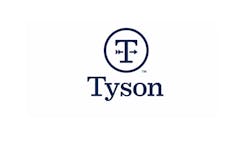Tyson Foods Inc., one of the world’s largest food companies and a recognized leader in protein with leading brands including Tyson, Jimmy Dean, Hillshire Farm, Ball Park, Wright, Aidells, ibp and State Fair, reported the following results:
First nine months highlights
- GAAP EPS of $7.42, up 60% from prior year; Adjusted EPS of $7.10, up 19% from prior year.
- GAAP operating income of $3,644 million, up 47% from prior year; Adjusted operating income of $3,591 million, up 15% from prior year.
- Total company GAAP operating margin of 9.2%; Adjusted operating margin of 9.1%.
- Repurchased 8.1 million shares for $693 million.
- Reduced total debt by approximately $1 billion.
Third-quarter highlights
- GAAP EPS of $2.07, up 1% from prior year; Adjusted EPS of $1.94, down 28% from prior year.
- GAAP operating income of $1,033 million, down 3% from prior year; Adjusted operating income of $998 million, down 27% from prior year.
- Total company GAAP operating margin of 7.7%; Adjusted operating margin of 7.4%.
- Liquidity of $3.3 billion at July 2, 2022.
“We delivered solid results during the third quarter, focusing on operational excellence and aggressive cost management," Donnie King, president and CEO of Tyson Foods, said in the announcement. "The turnaround of our chicken business continues, and we continue to be the market share leader in many of our retail business lines, which include our Tyson, Jimmy Dean, Hillshire Farm and Ball Park iconic brands.
"We maintained double-digit sales and earnings growth year to date as well as progressing toward our goal of delivering more than $1 billion in recurring productivity savings by the end of fiscal 2024.
"I'm optimistic about our ability to win with our team members, win with our customers and consumers and win with excellence in execution."
Summary of segment results
Beef sales volume decreased for the first nine months of fiscal 2022 despite strong global demand, due to the impacts associated with a challenging labor environment and supply chain constraints. Sales volume increased in the third quarter of fiscal 2022 driven by a strong global demand environment, partially offset by a challenging labor environment and continued supply chain constraints. Average sales price increased in the first nine months of fiscal 2022 as input costs such as live cattle, labor, freight and transportation costs increased and demand for our beef products remained strong. Average sales price decreased slightly in the third quarter of fiscal 2022 driven by reduced demand for premium cuts of beef as compared to exceptionally high demand in the third quarter of fiscal 2021. Operating income increased slightly during the first nine months of fiscal 2022 due to strong demand as we continued to optimize revenues relative to live cattle supply and a reduction in direct incremental expenses related to COVID-19, partially offset by production inefficiencies due to the impacts associated with a challenging labor environment and continued supply chain constraints. Additionally, operating income in fiscal 2021 was impacted by a $55 million gain from the recovery of cattle inventory related to a cattle supplier's misappropriation of Company funds. Operating income decreased in the third quarter of fiscal 2022 as margins began to reduce from historically high levels paired with continued increased operating costs. Additionally, operating income in the third quarter of fiscal 2022 benefited from $27 million of insurance proceeds related to a fire at a production facility in the fourth quarter of fiscal 2019.
Pork sales volume decreased in the third quarter and first nine months of fiscal 2022 due to reduced global demand. Average sales price decreased in the third quarter due to reduced export and retail demand. Average sales price increased in the first nine months of fiscal 2022 as input costs such as live hogs, labor, freight and transportation costs increased, partially offset by unfavorable mix associated with labor shortages. Operating income decreased in the third quarter of fiscal 2022 due to periods of compressed pork margins. Operating income for the first nine months of fiscal 2022 was relatively flat as reduced direct incremental expenses related to COVID-19 were offset by higher inputs costs and the impacts associated with a challenging labor environment.
Chicken sales volume decreased in the third quarter of fiscal 2022 primarily due to a reduction in volumes related to a fire at a production facility in the fourth quarter of fiscal 2021 and a reduction in outside meat purchases. Sales volume increased slightly in the first nine months of fiscal 2022 primarily due to strong global demand partially offset by a reduction in volumes related to a fire at a production facility in the fourth quarter of fiscal 2021. Average sales price increased in the third quarter and first nine months of fiscal 2022 due to the effects of pricing initiatives in an inflationary cost environment. Operating income increased in the third quarter and first nine months of fiscal 2022 primarily due to higher average sales prices, partially offset by the impacts of inflationary market conditions including increased supply chain and labor costs. In the third quarter of fiscal 2022, the company experienced $145 million of higher feed ingredient costs and $23 million of net derivative losses as compared to $56 million of net derivative gains in the third quarter of fiscal 2021. In the first nine months of fiscal 2022, the company experienced $430 million of higher feed ingredient costs. Additionally, operating income in the first nine months of fiscal 2022 benefited from $26 million of insurance proceeds, net of costs incurred related to a fire at a production facility and was impacted in the third quarter and first nine months of fiscal 2021 by $306 million and $626 million of losses, respectively, from the recognition of legal contingency accruals.
Prepared Foods sales volume decreased in the third quarter and first nine months of fiscal 2022 due to the impacts of increased pricing, uneven foodservice recovery, the divestiture of its pet treats business in the fourth quarter of fiscal 2021 and a challenging supply environment impacting the first half of fiscal 2022. Average sales price increased in the third quarter and first nine months of fiscal 2022 primarily due to the effects of revenue management in an inflationary cost environment. Operating income increased in the third quarter of fiscal 2022 due to higher average sales prices, partially offset by the impacts of inflationary market conditions, including $135 million of increased raw materials and other input costs in addition to increased supply chain and labor costs. Operating income was relatively flat in the first nine months of fiscal 2022 as higher average sales prices were offset by the impacts of inflationary market conditions, including $560 million of increased raw materials and other input costs in addition to increased supply chain and labor costs.
Outlook
For fiscal 2022, the United States Department of Agriculture (USDA) indicates domestic protein production (beef, pork, chicken and turkey) should be relatively flat compared to fiscal 2021 levels. The following is a summary of the outlook for each segment, as well as an outlook for revenues, capital expenditures, net interest expense, liquidity and tax rate for fiscal 2022.
Beginning in fiscal 2022, the company launched a new productivity program, which is designed to drive a better, faster and more agile organization that is supported by a culture of continuous improvement and faster decision making. It is targeting $1 billion in productivity savings by the end of fiscal 2024 and more than $400 million in fiscal 2022, relative to a fiscal 2021 cost baseline. The company is currently on track to achieve its planned productivity savings for fiscal 2022.
Beef
USDA projects domestic production will increase approximately 1% in fiscal 2022 as compared to fiscal 2021. The company anticipates another strong year with adjusted operating margin between 11% and 13% in fiscal 2022.
Pork
USDA projects domestic production will decrease approximately 3% in fiscal 2022 as compared to fiscal 2021. The company believes its Pork segment's adjusted operating margin will be 3% to 5% in fiscal 2022.
Chicken
USDA projects chicken production will increase approximately 1% in fiscal 2022 as compared to fiscal 2021. The company anticipates an adjusted operating margin of 5% to 7% for fiscal 2022.
Prepared Foods
The company believes adjusted operating margin will be between 8% and 10% in fiscal 2022.
International/other
The company anticipates lower results from its foreign operations in fiscal 2022 due to supply chain disruptions and other impacts related to COVID-19.
Revenue
The company expects sales to be $52 billion to $54 billion in fiscal 2022.








